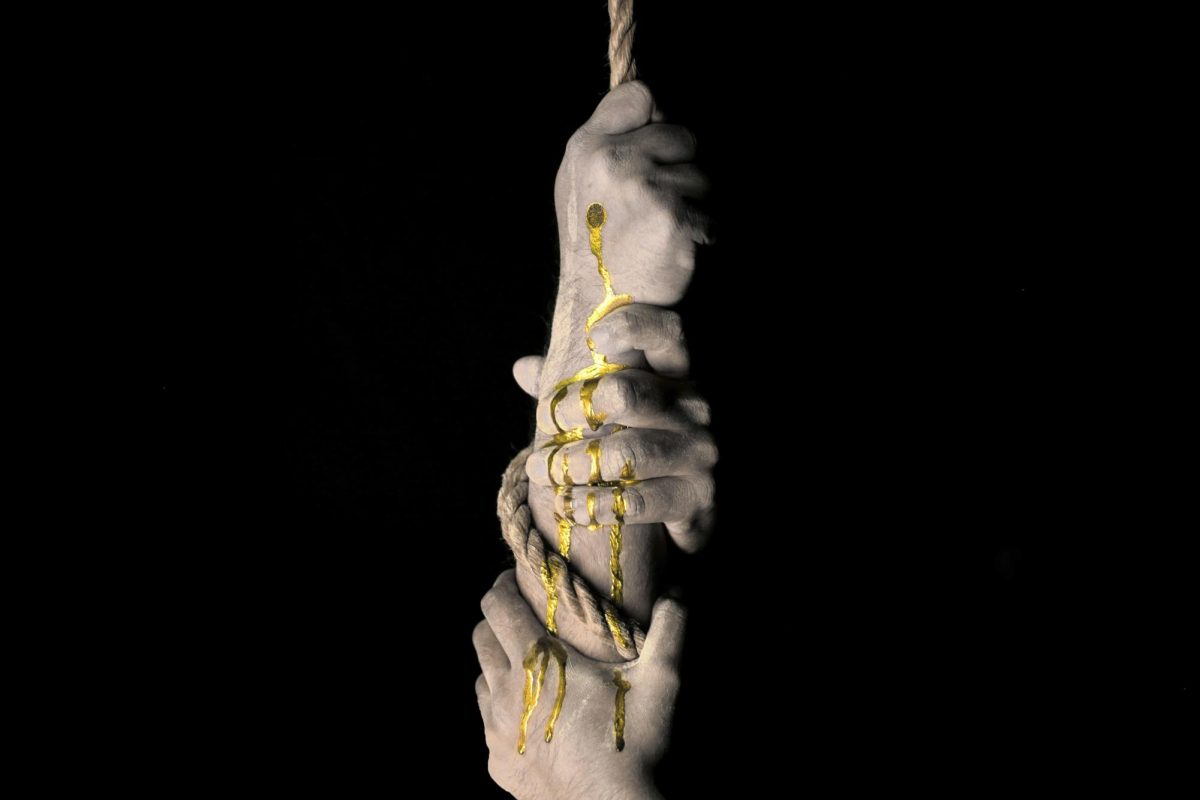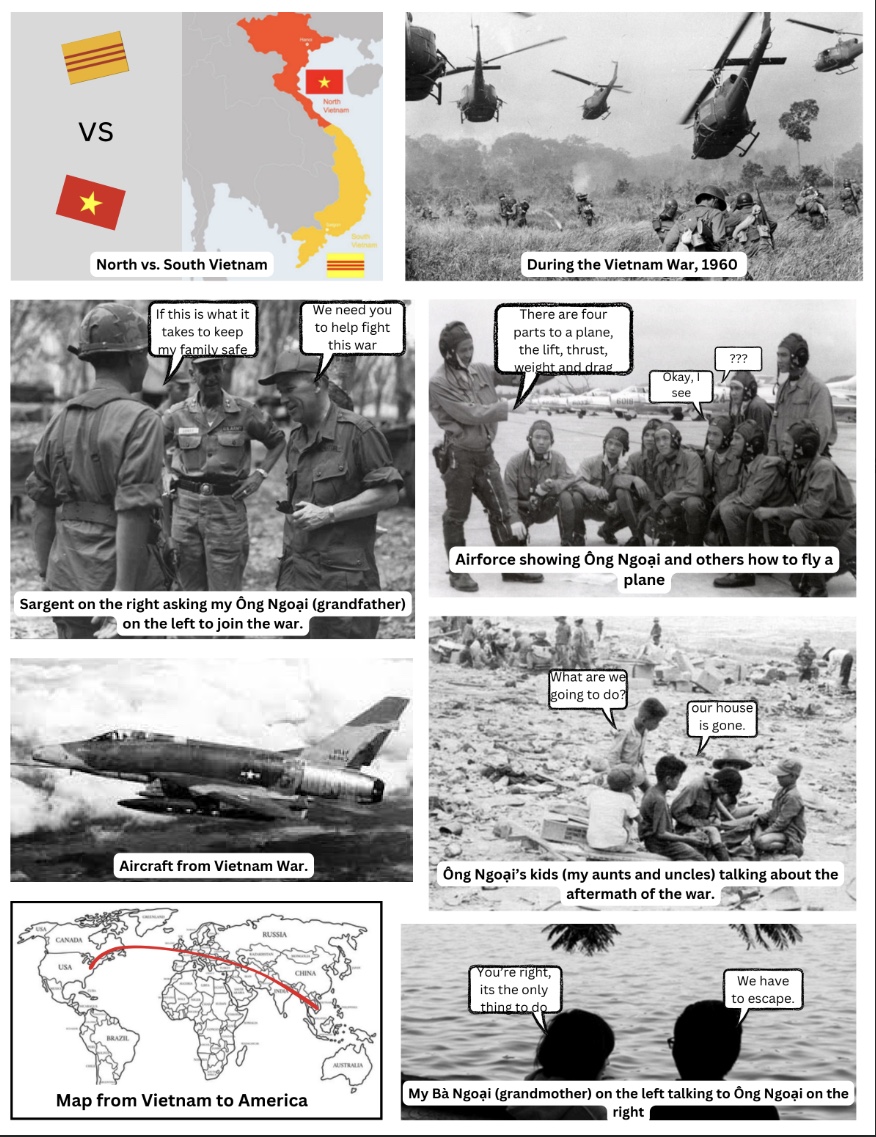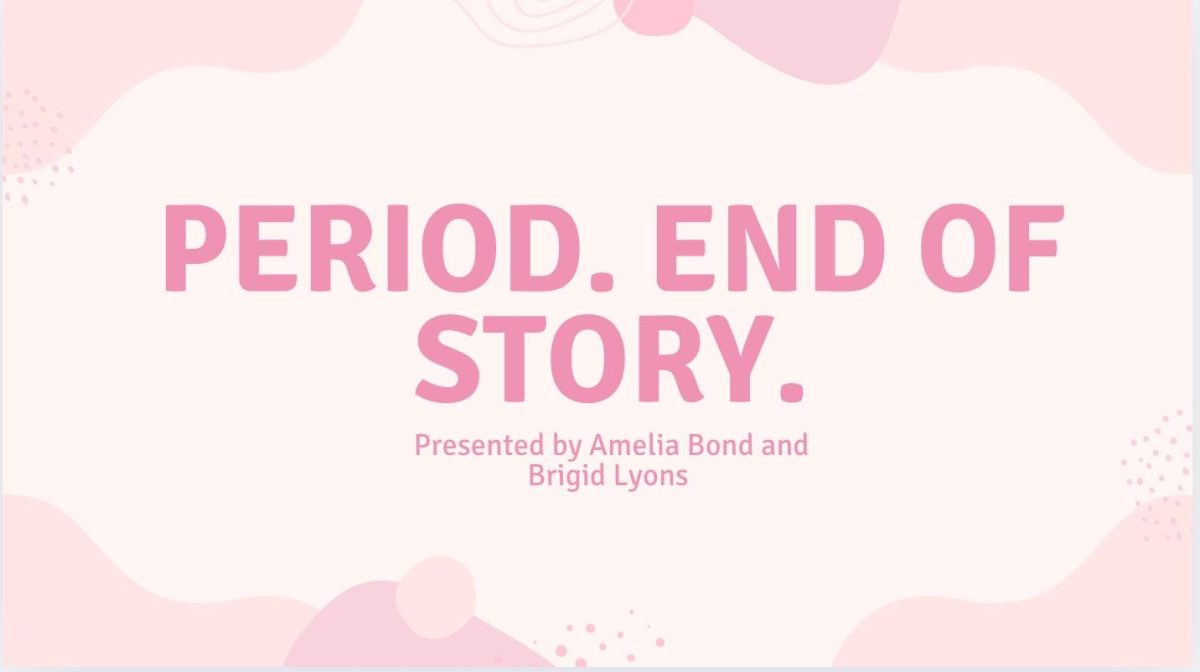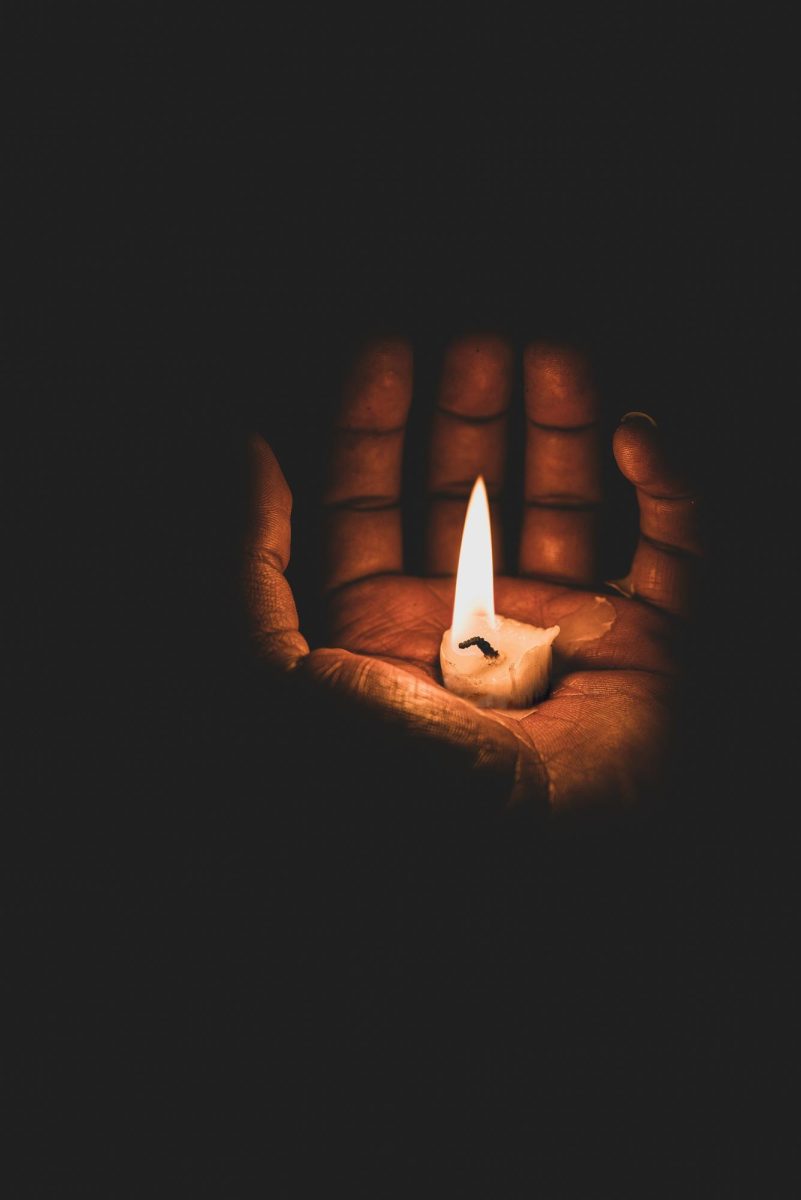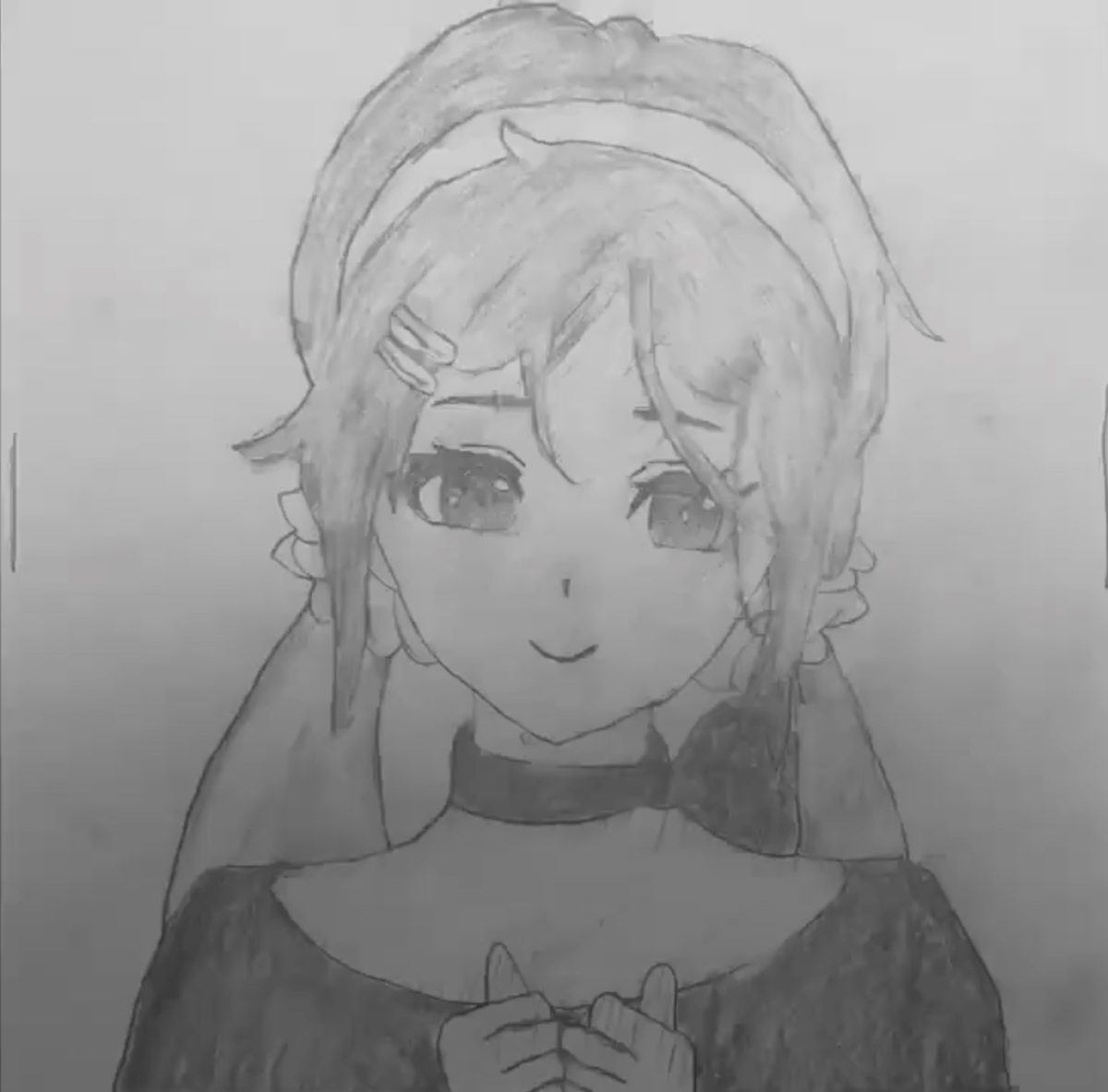Artist Statement
For my project, I focused on the topic of the empowerment of women. In the book, The Woman Warrior by Maxine Hong Kingston, the narrator of the story communicates with her mother through talk-stories. Talk-stories are stories told by the narrator’s mother about either the mother’s life experiences or someone else’s life. The narrator’s mother uses these stories to teach her daughter valuable life lessons. I interviewed the woman in my family and asked them to tell a story about a time they felt disempowered due to being a woman. Then I created a type of graphic novel that is a compilation of four stories from the women in my family followed by a reflection page written by me. The graphic novel includes AI-generated photos that I created. The reflection page ties the themes of their stories together and comments on the disempowerment of women in society.
Story One:
Equal Pay? That’s The Real Deal

In the early 1990s, my Aunt Joan worked as a public policy specialist in the field of children’s health and education. She was in her late twenties and accepted a position in the federal government with a pay increase from her previous non-profit employer. She was hired along with a white male of the same age from a real estate agency. Salaries are transparent in the federal government, meaning it’s no secret what a public employee makes. Within a couple of months, my Aunt Joan learned that her co-worker had been hired at a salary of $10,000 more than she was making for the same position. The co-worker spent a good portion of each morning reading the newspaper, took a full lunch break, and never stayed a minute past his work hours. She was shocked, angry and confused when she found out about the substantial pay discrepancy. She made sure that her information was correct, and then sought advice from another woman in the office who was in her early 40s and held a higher policy position. She validated Joan’s concerns that this discrepancy was unacceptable and helped formulate a plan for speaking with her supervisors about it.
Once Joan was confident with the plan and how she would articulate a request for equal pay, she set a meeting with her two supervisors – both were white males in their 60s. They were polite and sympathetic (and clearly uncomfortable) with the inequity Joan had discovered. Both were good people, but they had no lived experience with gender pay inequity. In that discussion, she learned that her starting salary had been formulated based on making a lower salary at the non-profit where Joan formerly worked (where she was an Assistant Director for Policy). It had less to do with her experience or education, which was incredibly frustrating! In the end, they negotiated a series of pay increases that would bring her up to her co-worker’s salary level.
After that experience, Joan always reminds women of their value and that one does not have to settle for less than they are worth. It is a hard fight for women – and know that it’s even harder for women of color. They have to support each other if they want to achieve gender equality in this country and globally. There are a lot of ways that women are treated unfairly in the U.S. and around the world. It’s not just pay. Their work as primary caretakers for families is undervalued and uncompensated (meaning there’s no pay or benefits provided for stay-at-home moms who care for children or aging family members). This experience helped Joan to become more committed to supporting the need to elect more female leaders who will work on their behalf – not give away more of their power.
Story Two:
The Scavenger Hunt Gone Wrong

At age eighteen, my sister Sofia went with her high school on a service trip to the Dominican Republic. There were nine students and two teachers who went on the trip, and they worked with a program called InspireDR that helped young Dominican Republic boys learn to become responsible adults, somewhat like boy scouts. Her group was there for a week, and during this time, Sofia became somewhat exhausted and sick from the high humidity and hot temperature. She hadn’t been feeling well for a few days, and one day the activity that her school group had planned with the local boys was a scavenger hunt around the village.
The students were split into groups, and Sofia ended up by herself, the only girl student, alone with three local boys who barely spoke English. She was fortunate because she spoke some Spanish, but their specific dialect and slang could be hard to understand. She found herself wandering the village alone with them for about an hour. She did not see any of her peers or teachers. She and the boys went through the streets, by a local river, on backroads, and into the woods. She realized that her life was in the hands of these boys she did not know well, and that anything could happen. She was scared, but she also realized that she had no one to depend on but herself. So, even though Sofia was scared, she focused on remaining calm and clear headed. She kept track of how to get back to the school and was prepared for the worst. She mapped out escape routes in her head and was grateful that she had taken a self defense course in the past. The worst part was that one of the items on the scavenger hunt list was to get a video of someone dancing with a person in the village. She and the boys eventually ended up at the public baths, where she felt pressured to dance with a man wearing nothing but a towel. She was so scared something would happen, especially since she was already feeling sick and was alone.
When they finally got back, Sofia was extremely relieved. On the one hand, it was a scary and a highly risky situation; however, the experience made her realize that she could handle herself in unpredictable and potentially dangerous situations and that she was braver than she thought. She kept her wits about her and gained grit, resilience and confidence.
Story Three:
Shame On A Summer Day

On a hot summer day in 1978, my mom, Dawn was eleven years old and playing outside on the lawn in front of her house with a bunch of her friends. They were at that age where their young bodies were developing from being girls to becoming women. They wore bikinis, and were being silly and free, and joyfully running in and out of the sprinkler. Across the street, Dawn’s neighbor was mowing his lawn and his two sons were helping out with landscaping. Suddenly, her mom came storming out of the house and yelled at her to get inside and to cover up. “You should not be outside dressed like that.” She appeared angry and glanced toward the men across the street. My mom, Dawn, went to her room. She felt confused, embarrassed and ashamed. What had she done wrong? Every summer she was outside in a bikini or one piece playing with her friends in the sprinkler. They rode around on their bikes in their bathing suits and never thought twice about how they were dressed. Suddenly, she was acutely aware of her changing body. Her mother did not talk to her about why she was upset or why Dawn should cover up. But Dawn knew from her mother’s reaction that something was wrong. She realized at that moment there was a difference between being a girl and being a woman. She had the sense of suddenly being prey, of wanting to hide, cover up, be smaller. She sat alone in her room feeling confused with no one to talk to.
Looking back, Dawn wished she’d talked to her mom and asked her to explain what she did wrong. It would have been helpful if her mother explained how Dawn’s body was changing. It would have been helpful if she explained to Dawn that she did not do anything wrong and that she did not have anything to be ashamed of.
My mom, Dawn shared with me that she felt disempowered, confused, and ashamed at the time, but as she got older, she gained wisdom. From that experience, she learned how important it is to talk to young girls and women about their developing bodies and teach them to love and honor themselves. She learned that women should not have to change how they dress or act just because there could be a threat of the wrong kind of attention, judgement, sexual assault, or harm. She is proud of her body, and gives herself permission to express herself freely. No hiding or shrinking. She focuses on being strong and assertive. Taking up space. Being seen. She models that self love and confidence for me and my sister.
Story Four:
No Marriage, No Kids, No Job

It was the 1990s and my Aunt Carole was a young woman in her twenties, working as an English teacher at a high school on Long Island. Due to budget cuts, the school began laying off teachers. A male colleague and Carole worked in the same department, but she had six months more seniority than he did. Despite this, Carole was let go while he was retained. The reason? She wasn’t married and didn’t have children, and was told, “Your time will come.”
Three years later, Carole returned to the school, as she was next in line to be re-hired. However, the administrator falsely claimed that the statute of return had expired, and she wasn’t re-hired. The principal explained that her male colleague had a family to support and another baby on the way, so she needed to “step aside” and not interfere with him keeping his job. Carole was also warned not to complain to the union because doing so would result in being blacklisted from other school districts on Long Island. She felt angry, frustrated and confused.
She left, hoping to return later. The chairman had promised her a position once she earned her second graduate degree, but when she returned three years later, that promise had been broken too. The position had gone to another man.
This pattern of sexism followed Carole throughout her career in academia. At her final teaching job as an acting professor at The Academy of Dramatic Arts, she was married, but still faced extreme prejudice. Her male chairman constantly commented on her figure and warned her not to become “fat and lazy” like other women after having children. His sexist remarks made the environment unbearable, so she chose to leave. This marked the end of Carole’s academic career and the start of a new path. She learned that these experiences were not her fault. She was a young woman being discriminated against for not following a traditional path of marriage and children. Carole was more focused on her career and passions, which intimidated some men.
She also learned the importance of staying true to herself. She became a life coach and has passed this wisdom on to other women who’ve face similar prejudices: to remind themselves that these biases have nothing to do with their abilities or worth. Carole learned to tune out others’ judgments about her life choices. In a way, it empowered her to pursue her dreams despite the doors that closed.
She teaches women that they may encounter prejudice in their lives because of being a woman. People will make judgments about women’s choices, their careers, and even their bodies. Standing up for oneself when they can, but don’t hesitate to walk away from people or situations that don’t serve them. She teaches them to march to the beat of their own drum and live their lives unapologetically. Surrounding themselves with like-minded individuals who support their journey and choices.
Reflection:

I interviewed the woman in my family and asked them to tell a story about a time they felt disempowered due to being a woman and how that experience affected them. I asked how the experience made them feel and what they learned from it. After hearing all of the stories, I initially felt discouraged and disappointed. I felt this way because in our society the abuse of power and authority is targeted at only a few groups of people including women. As a woman, it is difficult to exert your power and actually have people listen and care. All of these stories represent this in some way.
On the other hand, these stories make me feel less alone. This is because I know there are women all around me who have these similar experiences all the time. It’s important to remember that as humans there are always other people experiencing what you might be experiencing and that if we respect, support, and communicate with one another, changes can be made. From these stories, I learned that there will be disempowerment and hatred towards others based on their race, gender, sexuality, etc but there is a community of people around you who you can connect with and fight together.
I chose to ask the woman in my family to tell stories to represent the idea of talk- stories. In the book The Woman Warrior by Maxine Hong Kingston, the narrator’s mother teaches the narrator valuable lessons through a talk-story. The talk-stories in the book are typically about either the mother’s life experiences or another person’s life experiences with lessons learned.
One of the common themes among the women’s stories in my family was the feeling of being confused, alone, intimidated, and not having a voice. For example, my Aunt Carole and Aunt Joan both shared that they felt confused and intimidated. They both had to find their voice and confront the abuse of power. Sofia and my mom shared feeling confused and alone during their experience.
Another theme across the stories was that each woman learned something from the experience that empowered them later. These experiences helped each one to believe in themselves, build their confidence and learn to support other women to be empowered. For example, Sofia learned that she could keep a clear head and stay calm and focused while in a dangerous situation. This increased confidence in herself. Aunt Joan used the support of another woman and also faced the men who were giving the different salaries and stood up for herself. Aunt Carole left an abusive system, but then became a coach and empowers other women. My mom, Dawn took her experience and taught my sister and me to love our bodies.
In conclusion, I enjoyed hearing my aunts, sister and mother share these powerful stories. I enjoyed reading the talk-stories in the novel, however, actually listening to real talk-stories from the woman in my family was really moving. I loved hearing about how they overcame the challenges and I appreciate their wisdom and strength. I think in the future I want to take the lessons learned and apply them in my life. I would love to hear more of their stories.


